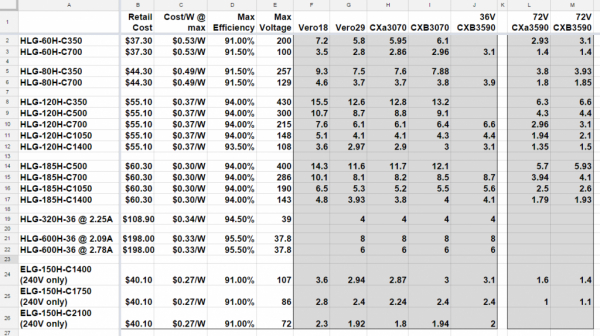Navigation
Install the app
How to install the app on iOS
How To Use Progressive Web App aka PWA On 420 Magazine Forum
Note: This feature may not be available in some browsers.
More options
You are using an out of date browser. It may not display this or other websites correctly.
You should upgrade or use an alternative browser.
You should upgrade or use an alternative browser.
Peachapoil
Active Member
WOW i love you !!
- Thread starter
- #3
AvidLerner
New Member
ThanksWOW i love you !!
Justwannagrow
Well-Known Member
There is something off with that though I've noticed or just confusing , vero 29 is 36.6v so times 8 is 192.8 but hlg-185h-c700 has a Max voltage of 286 for example, and it's off the same way with all the others, am I wrong
- Thread starter
- #5
AvidLerner
New Member
The way meanwell Constant Current drivers function is they balance volts through current balance. So the driver can go above the max by 5% I believe, so that current balances. minor variances in voltage are minor are you can be assured this data is accurate, as it is dated now almost two years but still valid, and used by many people as a guide.
- Thread starter
- #6
AvidLerner
New Member
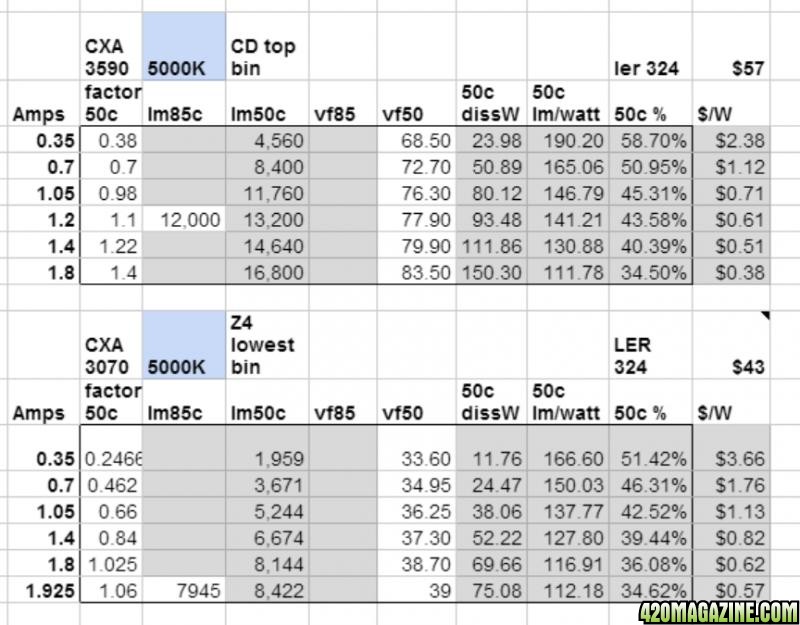

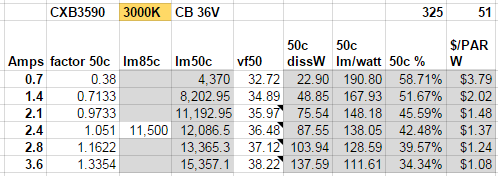
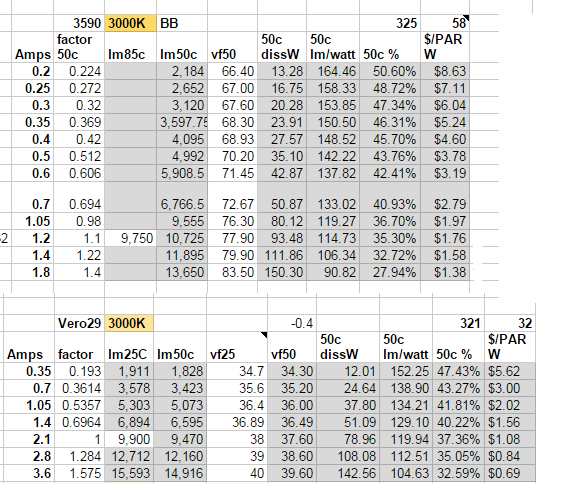
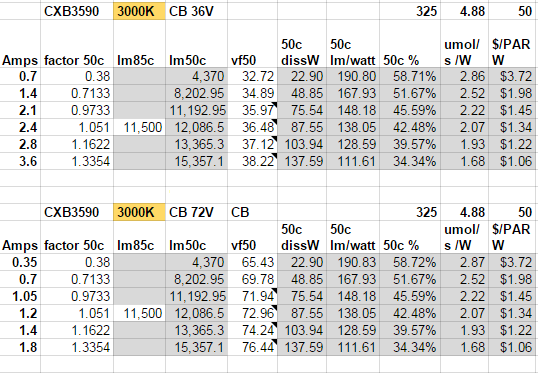

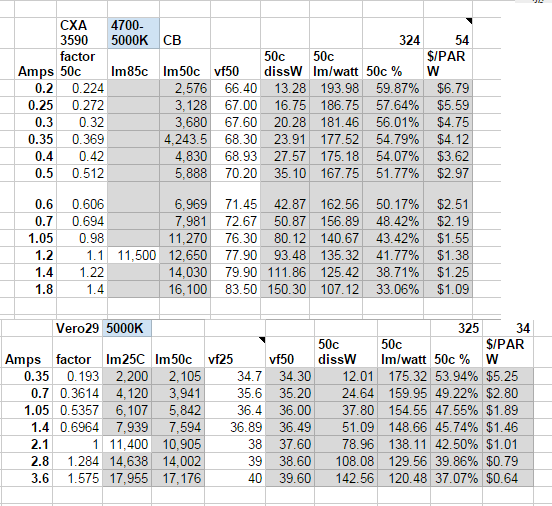
some moire data for folks, enjoy
- Thread starter
- #7
AvidLerner
New Member
Most of this data has been collected and distributed widely. enjoy share widely.
- Thread starter
- #8
AvidLerner
New Member
When you review specific data pay attention to lm/w that is the micromoles available at that current. Notice most cobs citizen vero and cree all respond with the highest micromoles at the 700mA current. That is not a mistake. Cobs are like BBQ low and slow except in cobs its low and great. Best energy exchange occurs at that range low current high micromoles or energy available for photosynthesis
- Thread starter
- #9
AvidLerner
New Member
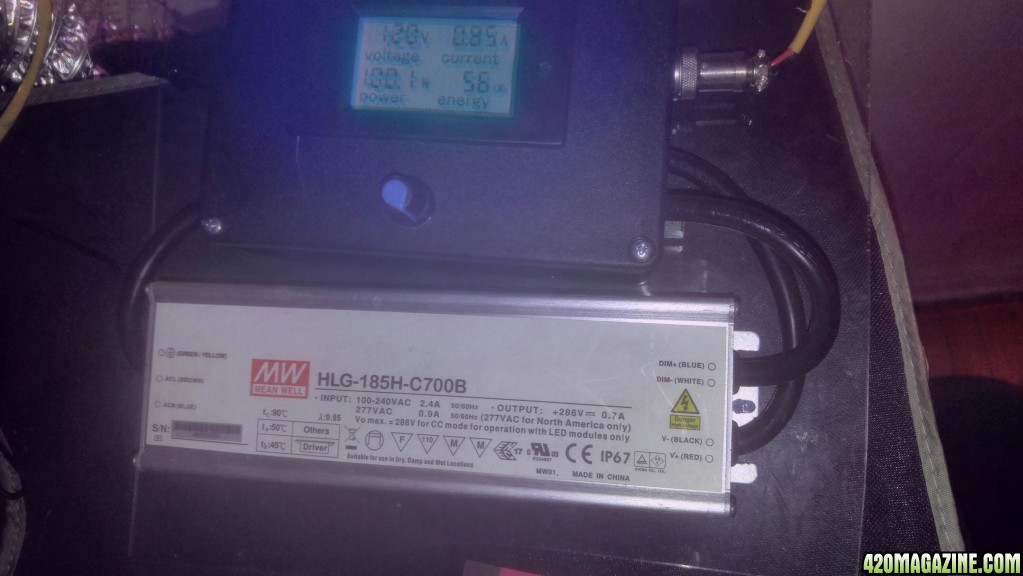
This an example of using cree cobs most efficiently. Notice the 5000k cxb3590 develops 240.5 lumens/watt or 3.32 micormoles/watt. That is the best you can get from this cree cob. This light fixture has 4- cxb3590 36v, 5000k 80 cri running at 36x x 0.7mA = 25w max. If I want to get 200 watts, all I have to do is add four more cxb3590's and I will get the most amazing growth in 4 sf for bloom. 25wpsf for veg is great 50wpsf for bloom is great, as well.
I hope this helps in understanding
namaste
Integrum Stultus
New Member
When contemplating lighting for plants lumens mean pretty much nothing. As the saying goes 'Lumens are for humans'
fanleaf
Well-Known Member
Actually as far as cobs go youre wrong. Lumens are the standard for cob manufacturers because they don't design them for Horticulture use. The thing is along with the spectral charts we can convert lumens that are within the par spectrum range to par/ppfd. The whole "lumens are for humans" thing that is like a bunch of parrots. People just repeating eachother. Lumens can give us plenty of info to work with.When contemplating lighting for plants lumens mean pretty much nothing. As the saying goes 'Lumens are for humans'
Integrum Stultus
New Member
PAR is what is available to your plants, not lumens. I disagree with part of your statement and in part agree.
And I quote....
'Lumens are probably what most people are familiar with when it comes to defining the intensity of different lights. The lumen is a unit of measure of the quantity of visible light emitted by a source. If you've done any research into grow lights, you've probably heard the phrase "lumens are for humans". This is derived from the fact that lumens are weighted according to a model of the human eye's sensitivity to various wavelengths. This weighting means that light in the green-yellow spectrum will register significantly higher in lumens than red or blue light — two colors that are very important for photosynthesis in plants.
If you're comparing 2 grow lights and measure 500 lumens per square meter from a light with a high (blue) color temperature vs. 1,000 lumens per square meter from a light in the green-yellow range, you might think the 1,000 lumen light is the clear winner, but this is not the case. While lumens may reflect how much light humans perceive, they do not adequately account for how much light your plants are actually receiving. There's a name for the specific type of light that we want to measure called PAR, and we'll get to this shortly.
Lumens are involved in a few different measurements, like luminous flux, lux, and foot-candles.'
The full read can be found here:
Lumens, PAR, PPF, and PPFD: Measuring COB Grow Light Output - The LED Gardener
We have differing outlooks, To each his own brother.
And I quote....
'Lumens are probably what most people are familiar with when it comes to defining the intensity of different lights. The lumen is a unit of measure of the quantity of visible light emitted by a source. If you've done any research into grow lights, you've probably heard the phrase "lumens are for humans". This is derived from the fact that lumens are weighted according to a model of the human eye's sensitivity to various wavelengths. This weighting means that light in the green-yellow spectrum will register significantly higher in lumens than red or blue light — two colors that are very important for photosynthesis in plants.
If you're comparing 2 grow lights and measure 500 lumens per square meter from a light with a high (blue) color temperature vs. 1,000 lumens per square meter from a light in the green-yellow range, you might think the 1,000 lumen light is the clear winner, but this is not the case. While lumens may reflect how much light humans perceive, they do not adequately account for how much light your plants are actually receiving. There's a name for the specific type of light that we want to measure called PAR, and we'll get to this shortly.
Lumens are involved in a few different measurements, like luminous flux, lux, and foot-candles.'
The full read can be found here:
Lumens, PAR, PPF, and PPFD: Measuring COB Grow Light Output - The LED Gardener
We have differing outlooks, To each his own brother.
fanleaf
Well-Known Member
Youre not understanding bro. I get what you are saying but you are only looking at half of the picture. Cob manufacturers data sheets give us lumens. And with the spectral information and the lumens we can then convert lumens to par via calculation. So yes lumens are for humans however we can convert lumens to par for our plants. So lumens do "mean shit" when building Cob arrays. Different temperatures of light do create more par then other temperatures has the article in your response shows. That's why I say along with this spectrum charts and the lumens per watt we can calculate par.PAR is what is available to your plants, not lumens. So Fan you are incorrect.
And I quote....
'Lumens are probably what most people are familiar with when it comes to defining the intensity of different lights. The lumen is a unit of measure of the quantity of visible light emitted by a source. If you've done any research into grow lights, you've probably heard the phrase "lumens are for humans". This is derived from the fact that lumens are weighted according to a model of the human eye's sensitivity to various wavelengths. This weighting means that light in the green-yellow spectrum will register significantly higher in lumens than red or blue light — two colors that are very important for photosynthesis in plants.
If you're comparing 2 grow lights and measure 500 lumens per square meter from a light with a high (blue) color temperature vs. 1,000 lumens per square meter from a light in the green-yellow range, you might think the 1,000 lumen light is the clear winner, but this is not the case. While lumens may reflect how much light humans perceive, they do not adequately account for how much light your plants are actually receiving. There's a name for the specific type of light that we want to measure called PAR, and we'll get to this shortly.
Lumens are involved in a few different measurements, like luminous flux, lux, and foot-candles.'
The full read can be found here:
Lumens, PAR, PPF, and PPFD: Measuring COB Grow Light Output - The LED Gardener
Integrum Stultus
New Member
I get that Fan. We use the wavelength data from the lumen values given. Youre misunderstanding my initial claim which is in fact explained in the article. A higher lumen valued light is not necessarily better than a lower one. It all depends on spectrum. Maybe I was a little to blunt with that comment.
It woulda read better had i stated higher lumens dont necessarily mean better.
It woulda read better had i stated higher lumens dont necessarily mean better.
fanleaf
Well-Known Member
Yep, we agree 100%. Lumens + spectrum chart allows us to calculate par. It's not so much that I misunderstood you but as I'm sure you know the whole lumens are for humans thing gets repeated a crazy amount when they actually can be very important. . we are all good bro!I get that Fan. We use the wavelength daya from the lumen values given. Youre misunderstanding my initial claim which is in fact explained in the article. A higher lumen valued light is not necessarily better than a lower one. It all depends on spectrum. Maybe I was a little to blunt with that comment.
It woulda read better had i stated higher lumens dont necessarily mean better.
Integrum Stultus
New Member
They provide data in lumens because the lights are made for lighting are homes and such. But by using the data sheet and info contained within we can pull par values spectrum etc. to adequately make are ladies pray for the heavens..
That I do buddy. Too many ppl dont take the time on this forum to investigate shit. I dont even grow with cobs but have been reading and educating myself. I see alotta ppl using them. It seemed like something that would add to my repertoire of knowledge in horticulture.
That I do buddy. Too many ppl dont take the time on this forum to investigate shit. I dont even grow with cobs but have been reading and educating myself. I see alotta ppl using them. It seemed like something that would add to my repertoire of knowledge in horticulture.
fanleaf
Well-Known Member
haha, that was crazy for a sec. Yall have a good one. Imma roll one up and veg out.
fanleaf
Well-Known Member
Avid.I'm honestly sorry we got off to a bad start bro. I only get abrasive when enough is enough man. You caught the tail end of something that went much further then what you seen in my thread. There was wayyy more to that story. Enough of that though. Sometimes its hard to put the "tone" youre looking for with your words ya know? Just so happens I have an especially hard time with that lol.
Thanks Askhole! I see your stuff on here all over man. Much respect to you too.
Thanks Askhole! I see your stuff on here all over man. Much respect to you too.
Integrum Stultus
New Member
Appreciate it buddy. When I started cutting my teeth you were there brother. Your kind words and tutelage got me to where I am today with our craft. Much respect. I pay it forward where its deserving and you sir are a mentor of all sorts on this forum. All members who interact with u should be grateful they have had the chance to pick a masters mind...
- Thread starter
- #20
AvidLerner
New Member
PAR
Photosynthetic Active Radiation (PAR) was derived from the Mcree Curve. It is a total count of light energy (in photons) between 400nm to 700nm.
The PAR measurement is quickly becoming a popular metric of the growing power of a light source. However, the PAR measurement has two fundamental flaws.
Wavelengths between 380nm to 400nm and 700nm to 880nm are excluded from the PAR measurement.
All photons are weighted equally regardless of wavelength.
The Mcree Curve clearly shows plants respond to energy outside the 400nm to 700nm PAR range. Plants respond differently to energy within the PAR range.
A PAR meter only measures photons between 400nm and 700nm. As you can see in the example above, PAR does not distinguish which photons of light are present; it only counts the total amount of photons present in those nanometers.
spectral distribution spectral distribution
Photosynthetic Active Radiation (PAR) was derived from the Mcree Curve. It is a total count of light energy (in photons) between 400nm to 700nm.
The PAR measurement is quickly becoming a popular metric of the growing power of a light source. However, the PAR measurement has two fundamental flaws.
Wavelengths between 380nm to 400nm and 700nm to 880nm are excluded from the PAR measurement.
All photons are weighted equally regardless of wavelength.
The Mcree Curve clearly shows plants respond to energy outside the 400nm to 700nm PAR range. Plants respond differently to energy within the PAR range.
A PAR meter only measures photons between 400nm and 700nm. As you can see in the example above, PAR does not distinguish which photons of light are present; it only counts the total amount of photons present in those nanometers.
spectral distribution spectral distribution
Similar threads
- Replies
- 4
- Views
- 1K
- Replies
- 109
- Views
- 15K



